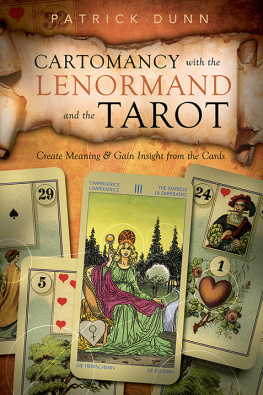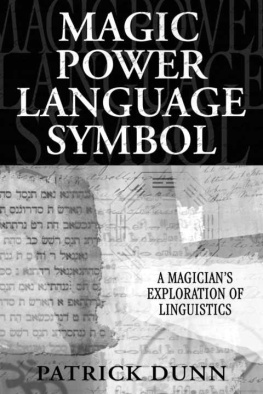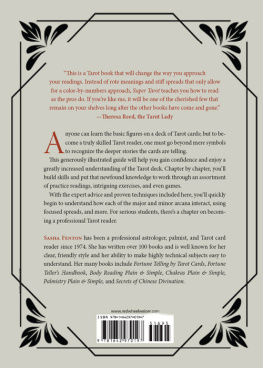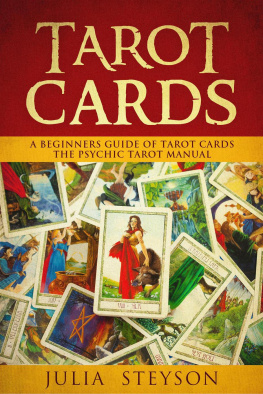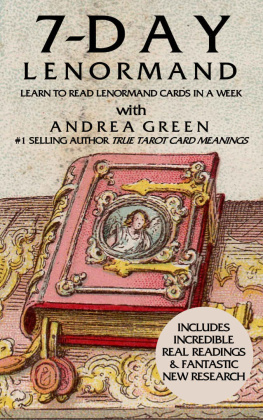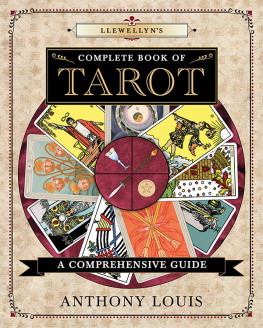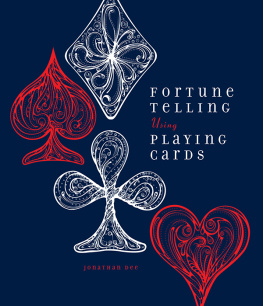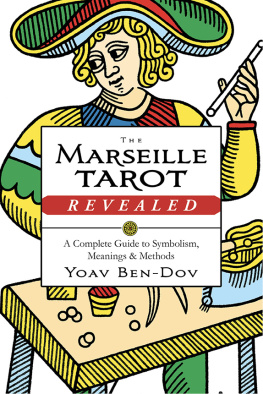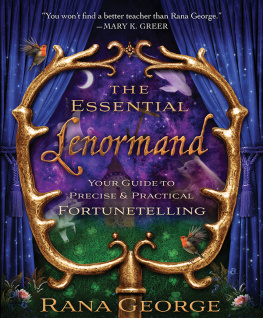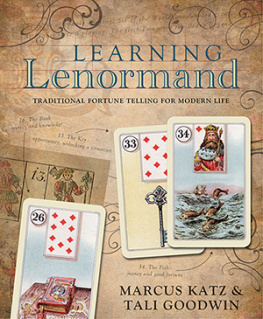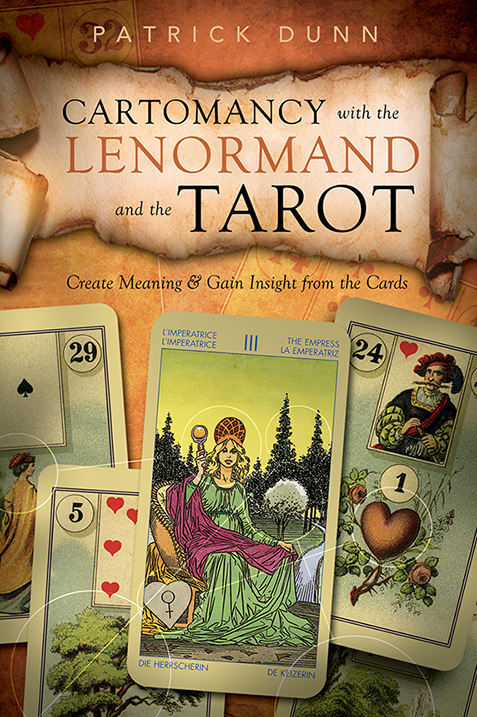Patrick Dunn has studied witchcraft, the Qabalah, chaos magic, and anything else he can get his hands on. In addition to obtaining his PhD in literature, he has studied linguistics and stylistics. He lives in Illinois, where he teaches English Literature. Dunn is also the author of Postmodern Magic: The Art of Magic in the Information Age.
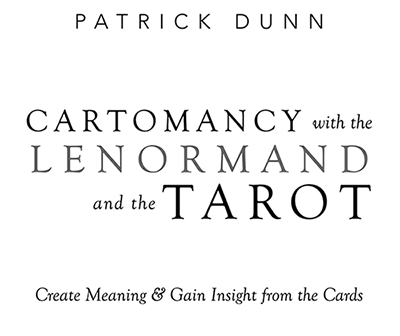
Llewellyn Publications
Woodbury, Minnesota
Copyright Information
Cartomancy with the Lenormand and the Tarot: Create Meaning & Gain Insight from the Cards 2013 by Patrick Dunn.
All rights reserved. No part of this book may be used or reproduced in any matter whatsoever, including Internet usage, without written permission from Llewellyn Publications, except in the form of brief quotations embodied in critical articles and reviews.
As the purchaser of this e-book, you are granted the non-exclusive, non-transferable right to access and read the text of this e-book on screen. The text may not be otherwise reproduced, transmitted, downloaded, or recorded on any other storage device in any form or by any means.
Any unauthorized usage of the text without express written permission of the publisher is a violation of the authors copyright and is illegal and punishable by law.
First e-book edition 2013
E-book ISBN: 9780738736754
Cover art 2013
Vintage paper scroll iStockphoto.com/Alexander Novikov
Cover design by Kevin R. Brown
Editing by Laura Graves
Interior illustrations Llewellyn Art Department except Robert Fludds Mirror of the Whole of Nature Image file courtesy of Liam Quinn: www.fromoidbooks.org
Interior tarot card art (reprinted by permission):
Lo Scarabeo: Universal Tarot Roberto DeAngelis
French Cartomancy Tarot Madame Lenormand & Laura Tuan
Llewellyn Publications is an imprint of Llewellyn Worldwide Ltd.
Llewellyn Publications does not participate in, endorse, or have any authority or responsibility concerning private business arrangements between our authors and the public.
Any Internet references contained in this work are current at publication time, but the publisher cannot guarantee that a specific reference will continue or be maintained. Please refer to the publishers website for links to current author websites.
Llewellyn Publications
Llewellyn Worldwide Ltd.
2143 Wooddale Drive
Woodbury, MN 55125
www.llewellyn.com
Manufactured in the United States of America
To my mother,
Joyce,
who taught me the tarot
and so much more
Contents
: What Is the Lenormand?
: The Meanings of the Lenormand Cards and Making Your Own Deck
: A Brief Description of the Major Arcana
: Occult Symbolism and the Anima Mundi
: The Symbolic Structure of the Major Arcana (or, Throw Away Your Little White Book)7
: Getting in the Mood, and Getting Ready to Read
: Preparing to Tell the Story
: Some Tarot Spreads
: Some Lenormand Spreads
: The Grammar of Symbols
: Intuitive Reading
: Collaborative Reading
: Symbolic Interaction Between the Lenormand and Tarot
: Synergy
: DIY
: Divination and Magic
: Keys of Cardboard
: Okay, Fine, A List of Meanings for the Cards, if You Insist
: Lenormand Keyword Table
Acknowledgments
I m always tempted to simply list everyone I know in acknowledgments, because I am blessed with so many wonderful friends, neighbors, and colleagues in every part of my life. I will limit myself, however, to just a few, with no implication that others are not also worthy of thanks for their help and support, witting and unwitting.
I wish to thank Richard, for his encouragement and patience with my writerly quirks.
Thanks also to my friends Chris, Ryan, Peter, and Eric, all of whom have shaped my thoughts through discussion, debate, and the best kin d of academic argument. Thanks to Chris again, for reading an early draft of this book and offering his usual helpful feedback.
Thanks also to the Aeclectic Tarot forums, where the community of Lenormand readers are more than willing to share their techniques and ideas.
I also thank the Kindred Spirits Intuitive Arts Center in Oswego, IL, for hosting me on several occasions as a guest and showing interest in my work.
Mary K. Greer offered honest, helpful, and knowledgeable criticism of an earlier version of this book, and for that and the improvement it made to the book, Im very grateful.
Elysia Gallo, my editor at Llewellyn, has been a great help. Editors do a lot more than mark apostrophe errors. Without good editors, books would never see the light of day, and Llewellyn has some of the best editors in publishing. I am grateful for her assistance, her spot-on suggestions, and her patience with those same aforementioned writerly quirks.
If Ive missed anyone, I hope they will not take it as a sign of ingratitude, instead of the honest mistake that it is. And, of course, there are helpers invisible to sensate eyes whom I also must thank, but Ill refrain from listing their names here.


Heraclitus, frag. 93
The Lord whose oracle is at Delphi
neither speaks clearly nor conceals, but signifies.
Introduction
O n the surface, this book is about cartomancy, the art of divination through the use of cards. I focus on two particular decks: the tarot and the Lenormand, decks of divination cards based on playing cards. I wanted to approach the Lenormand this way because it is little-known in the United States, but the tarot is familiar to many people. I wanted to use the tarot as a gateway into the Lenormand, which I have found a rewarding system in its own right. At the same time, I wished to say some modestly new things about the tarot and to provide some ways to use the two systems together that have proven useful to me personally. The universal symbolism of the Lenormand, so accessible and simple, can shine a clear light on the tarot, and the complex cosmology and philosophy of the tarot can lend depth and meaning to the Lenormand. That is one level of what I am trying to accomplish with this book.
Read at another level, this is a book about types of knowledge and ways of listening. The idea that random pieces of cardboard can tell the future seems absurd. And yet, after years of experimenting, I conclude that they can at least forecast (if not predict) with as much accuracy as the meteorologist. So this book serves as a meditation on the strangeness of that worldview and the wonder of it.
The traditional approach to the Lenormand is to lay out a list of meanings for the cards, both singly and in combination with each other. Different countriesand, to be honest, different readersall have slight differences in what particular cards mean, and some readers will even argue about the right meaning of a card. This traditional approach is not my own. I respect it as an approach, and I certainly respect the tradition. But tradition is not monolithic; it is not an unchanging monument that we must just salute. I approach the cards with a more postmodern spirit, seeing them as a collection of symbols that gain meaning in their relationships to each other but also in their relationships to those who use them. A simple list of meanings, while useful for some, is not this books goal. I respect and honor the traditions of Lenormand reading, but this is not an entirely traditional book.

